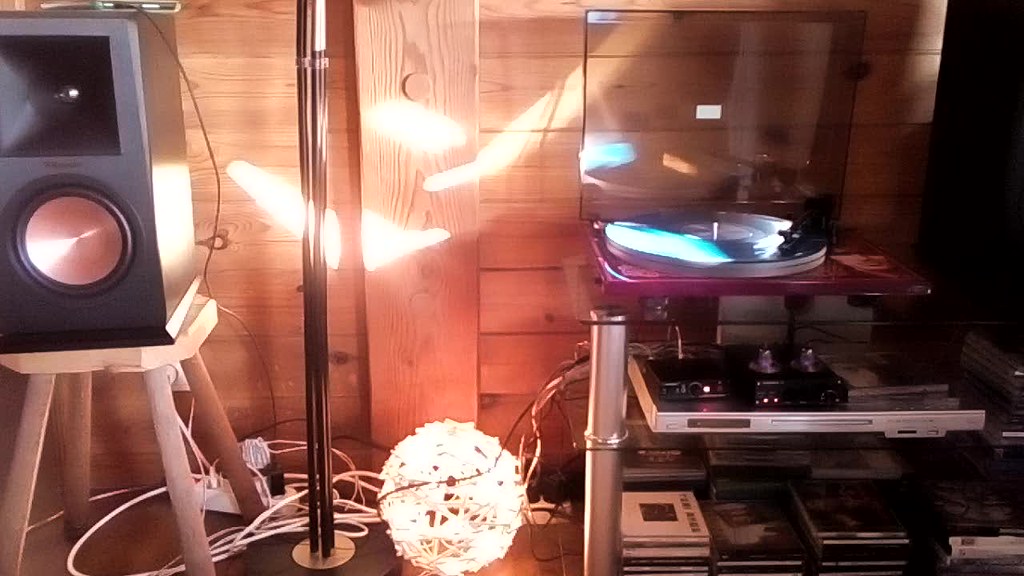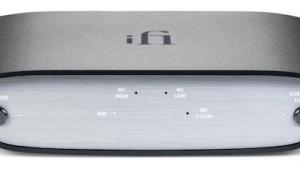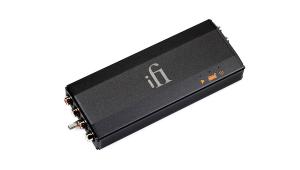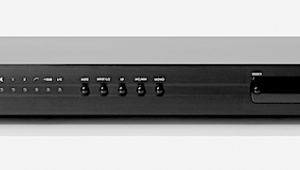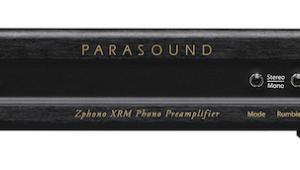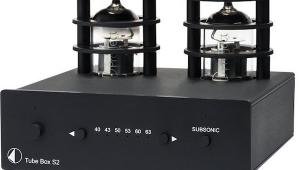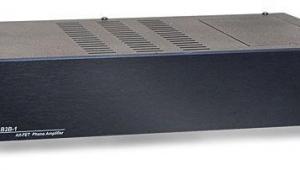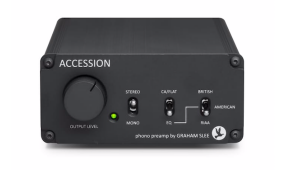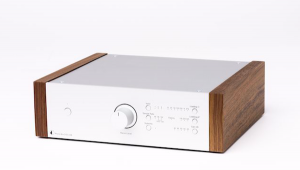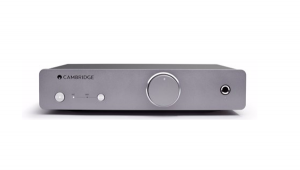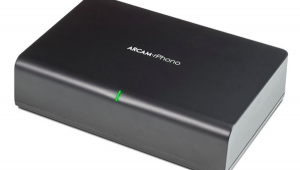... here's an opportunity for him to show off his soldering skills.
Spend about $3 for an LM4562 op-amp to replace the NE5532 and determine if there is any improvement in sound quality.
This $19 Pyle Phono Preamp Is Anything But Crap
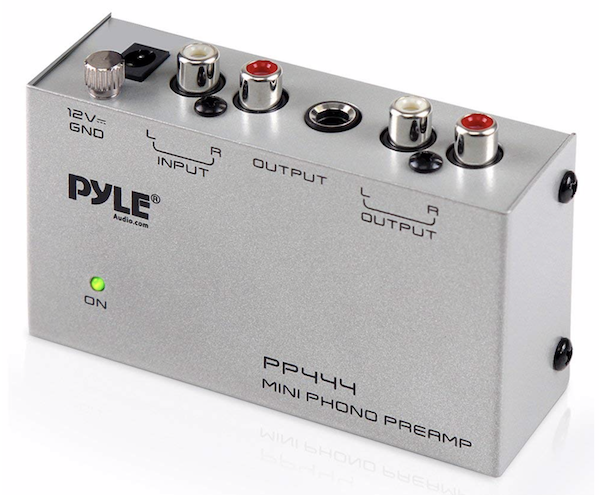
Features
The PP444 is an MM-only phono preamp built around a Texas Instruments NE5532P op-amp chip. It comes with a DC 12-volt power adapter and has an input sensitivity of 3mV at 50k ohms. A green LED indicates that the extremely small and lightweight unit is plugged in and ready.
In addition to the standard RCA output, there is also a ¼” phone jack line level output . It’s not a headphone jack to so don’t plug in your headphones because what comes out is loud! Pyle’s claim that the PP444 features “state of the art circuitry” is obviously false, but that doesn’t mean it’s bad. The build quality is as expected for the price - it holds up well but it’s nowhere close to indestructible. My only gripe about the PP444’s construction is that it lacks rubber feet that could prevent scratching up whatever surface you place it on, but again, it’s $19.
Setup
Once spoiled by the smoother sound of the far more costly Ortofon Quintet S MC, returning to the Elys2’s exaggerated bass and treble proved difficult so I installed the $49 Audio-Technica AT95E cartridge on my Rega P3 (with the Stein Music “Perfect Interface” carbon mat), which to me sounds much better and is a fraction of the Elys2’s price. I used a pair of Spiral Groove GrooveLine interconnects from the Pyle PP444’s output to my Onkyo TX-8260 integrated amp/stereo receiver.
Listening
The first thing I played with the Pyle/AT combo was Supertramp’s “The Logical Song” from MoFi’s recent reissue of Breakfast In America (MFSL 1-471). This album is known for having many elements spread across the soundstage, but also for its awful, overhyped cymbal sound especially on “Gone Hollywood.” The Pyle delivered a satisfying sound, without greatly over-emphasizing the cymbals and overall produced a rocking performance. When I returned to the MoFi UltraPhono (loading at 47k ohms), however, image stability, soundstage width, and definition greatly improved. I felt that I heard more of what was on the record, and the beginning of the saxophone solo specifically had more urgency. In addition, drum reverb was reproduced much better and the soundstage was deeper, too. But again, this is the difference between $19 and $250 (the $499 UltraPhono’s headphone amp doubles the price of the otherwise identical $249 StudioPhono) phono preamps. The UltraPhono’s superior performance is definitely worth the price difference, but the Pyle sounds extremely good for its price point and it can perfectly suit those just beginning to explore the analog world.
To test the Pyle’s bass, I played “TAPE” from BROCKHAMPTON’s excellent iridescence (2LP clear vinyl, RCA/Question Everything, Inc. 19075-90439-1), my favorite rap album of 2018. iridescence was mostly recorded at Abbey Road Studios and sounds excellent, especially for a modern rap album. “TAPE” features real string arrangements, deep bass, a dense beat, and verses from four BROCKHAMPTON members. For this test, I also threw in for comparison the MM phono input of the Onkyo amp, and the results were interesting. The UltraPhono’s bass was tighter, but the Pyle was no slouch and performed extremely well. Of the three, the Onkyo’s phono input was the worst, producing a strange haze over JOBA’s verse that once noticed couldn’t be un-heard!
Even though for $19 the Pyle PP444 sounds great, extreme disappointment crept in when I played the Raconteurs’ excellent “Now That You’re Gone”/”Sunday Driver” single (colored vinyl 7”, Third Man Records TMR-586) released by the Third Man Vault in December. An overly soft snare drum sound marred “Now That You’re Gone” and “Sunday Driver” didn’t rock nearly as much as it should have, but those in the market for a $19 phono preamp probably won’t know the difference.
Conclusion
Despite being a bit soft and not having the crystal-clear top end of more expensive phono preamps, considering its miniscule price tag, the Pyle PP444 over-performed. The subpar build quality was as expected, and the lack of rubber feet irritated, but the electronics inside did enough justice to even a $1600 turntable setup. Because of that, for those entering the wonderful world of vinyl and audiophilia on a tight budget, I highly recommend the PP444
- Log in or register to post comments


As far as I can tell, reviewers at analogplanet are real humans too, although I'm not always sure... ;-)
You always use the same text format, throw in the typical audiophile vernacular (soundstage, image, top end, the lows ...), a (pseudo-human) anecdote, a sceptical section, an elusive, eclectic playlist, and finally a conclusion in which the aparatus is plugged...
Anyone with basic code writing skills can create a program/bot that will create endless product reviews and generate a monthly income to live off...
I'm joking, of course...

Someone named Ivan? In Belgium?
Clearly a Russian bot, intent on exploiting the digital vs. analog divide to further confuse American audiophiles. уходить, vile demon!

You caught me... I used this site to create my 'avatar-face'
https://petapixel.com/2019/02/19/this-website-generates-ai-portraits-of-...
(It is off-line now, though...)

Malachi: For this review your set-up was a $19 phonostage, a $49 cartridge, and a $599 mat. I agree that the Pyle stuff is a lot of fun and sounds surprisingly good, but I am curious how much the mat contributed to your positive reaction to the overall sound. If you're recommending this for those on a "tight budget," I think this is important.
Thanks.

One of my students bought this because it was definitely in his budget. Hooked up his newly-bought Audio-Technica ATLP120 and before you know it was hooked on listening to the albums he inherited from his family.

The pre-amp I use is a €34 China made aparatus with the name 'IAMNOBODY' - no joke. It is amazing...
Today I was listening to some vinyl records (U2, Songs of Experience). By chance, a light beam fell upon the vinyl and was reflected upon the wooden wall behind the turntable. The result was an enlarged image of the imperfect rotation of the vinyl record, and I found it quite spectacular. The miracle is, of course, that the sound that the turntable produces, is unaffected. (In this case, a newly acquired Pro-Ject Essential III, George Harrison special edition with a standard Ortofon OM10 needle).
This 'old' technology is at the top of its game, really, and even this entry level audiophile turntable easily works around substantial torque, push and pull, as can be seen in the video:
https://flic.kr/p/SPmdZo

In the 70s and early 80s, in audio and especially video, most moderately-priced options were dreadful by today’s standards. But if you paid $50K (in 1980 $s) for a Barco projector, a few tho more for a line doubler and only watched Laserdiscs (and later, Japanese Muse), you could get an image that rivaled today’s offerings. Technological progress, along with developing-world manufacture changed all that. Today a $1K projector playing Bluray will have a better image with more light.
The same goes, perhaps more so, for a phono preamp. $19 will of course get you something decent. $100 should get something perfect. $5,000 will get the Emperor’s new clothes. With a $19 preamp inside. Because there is really no new technology to cost that much.

We've tried two of these for customers of ours (We're a dealer), and they have both failed. And try to talk to the company itself! The first customer simply went out and purchased a turntable with a built in phono preamp, but the second one gave us fits. We had to actually send back this phono preamp to the manufacturer, so they could "test" it. After a month, we called them and asked if they had fixed it, or if they were going to send us a replacement. Talking about rude! We told them to just keep it, and we ended up selling our customer one from BBE, available at Guitar Center. This was recommended by the people at Pro-Ject. It worked fantastic...

Well, for $19, the listed warranty on Amazon states "1 YEAR WARRANTY: We guarantee this electric phono preamplifier with both a 30 day no hassle money back return policy and a 1 year manufacturer’s guarantee." This seems sufficient to me as consumer. Reliability isn't really something you can measure without a huge sample size. So I wouldn't expect Malichi or any product reviewer outside of Consumer Reports to have the resources to do this kind of testing, as this more their specialty.
Knowing a little bit about Reliability of electrical components, their failure rate typically follows what is known as a bathtub distribution. Early in the life span their are high failure rates. As time passes, the failure rate drops to almost zero. Then the rate quickly escalates as the electronics fail and near the end of it's designed lifespan.
https://www.weibull.com/hotwire/issue21/ht21_1.gif
Indecently this why it's statistically not a good idea to buy an extended warranty for electronic devices. The coverage will never extend into the end of life portion of the curve. An extended warranty will only cover those failures at the bottom of the bathtub curve.

We are not in the business to bash others. However, we experienced nothing but bad luck with this piece. The "warranty" is a wonderful thing when the manufacturer honors it. This manufacturer (a one-man show) has shown no interest in taking care of customers. After installing one in a customer's home, we experienced a crackling sound. We called Pyle to request an exchange, and we were told we would have to send that one back, so they could test it. I called weekly, but they "hadn't got to it yet". Can you imagine hearing something like this over a $19 product?! Oh, and they made us pay for shipping. The guy argued with me over the phone and said they would FIX it and not send me a replacement. After a couple months, we just gave our customer a new phono preamp by BBE from Guitar Center. About three months later, a new Pyle phono preamp showed up at our store. It immediately found its way to the dumpster...

I can afford something better than the Pyle, though I may get one for my girlfriend's home. I read the positive review of the Cambridge Audio Duo on this website, and have seen other websites applaud the MoFi StudioPhono. I don't have anyway to listen before purchasing. The mono feature is intriguing on the MoFi, but if I have to buy blind, I'd go with Michael's opinion of the Duo. I would appreciate opinions based on actual experience. Thanks

The MoFi has more loading options if you ever switch to MC, so it's a better long-term plan than the Cambridge IMO. The Cambridge only has one MC loading option, and that is 100 ohms. But if you don't plan on switching to MC anytime soon, then the Cambridge might be worthwhile for you. I haven't heard the Cambridge myself, though. BTW, the mono switch on the MoFi Studio/UltraPhono is cartridge dependent. It makes a difference on some carts while not on others.

... do you presently have?
Any plans to get a low-output moving-coil type cartridge?
Do you need a headphone output on the phono preamp?

I have an older JVC VL-8 with an Ortofon 2m Red cartridge. Thanks for your interest.

I don't need a headphone output.

... Cambridge Solo.
https://www.cambridgeaudio.com/usa/en/products/hi-fi/phono-preamp/solo
In the future you might consider upgrading with a 2M Blue stylus.

The ART DJPRE II or ART USB Phono Plus also sounds surprisingly good, way better than the built-in on my AT-LP120. The USB version also allows line level input-to-USB conversion.

When I read a review like this, it reminds me that even those who can't spend thousands on high end can still have a great listening experience.

It's a joy to learn more about costly state-of-the-art analog playback components and devices, but for many of us it's even more practical to be informed about currently-available low-cost high fidelity audio components which we can purchase and enjoy within our real-world financial limits.

The ART DJ PRE II is miraculously good for the money (currently $49 with free shipping from the usual sites; occasionally it goes on sale for $39). I've installed several of these for customers and haven't had any problems yet. The switchable rumble filter is an especially good feature for people with inexpensive or old turntables, which tend to have more rumble than high-end turntables. AFAIK the Pyle doesn't have a rumble filter. The only complaint I've ever had has been about the blue LED light. This was easily fixed by careful use of a black Sharpie marker. :)

I found an AudioScienceReview.com review with measurements of this Pyle PP444 preamp. Their measurements show bass response down -3.4dB at 20Hz, and -2dB at 100Hz. That would most definitely be audible. Did anyone notice a lack of bass, or overly bright presentation?
Also, the little wallwart SMPS power supply is really noisy. Was that noticeable? Just curious...
